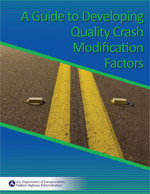CMF Update, Winter 2011
The Winter 2011 edition of CMF Update is the third edition of the Crash Modification Factors Clearinghouse e-newsletter. To subscribe to our newsletter, please visit http://www.cmfclearinghouse.org/newsletter_signup.php. To view archived issues, please visit http://www.cmfclearinghouse.org/newsletter.php.
New CMFs added to the Clearinghouse
Over 140 crash modification factors (CMFs) have been added to the Clearinghouse, with an additional 117 being added in March 2011. Since the CMF Clearinghouse was launched in December 2009, over 1,070 new CMFs have been added to the online resource. Collectively, the clearinghouse now contains over 2,680 CMFs for over 640 countermeasures.
Featured CMFs
Each edition CMF Update will feature CMFs of interest. The CMF Clearinghouse continually updates the online resource with new CMFs. Below is the list of this edition's featured CMFs.
Install high-visibility yellow, continental type crosswalks at schools
CMF: 0.63
CRF: 37
Star Quality Rating: ![]()
Implement automated speed enforcement cameras
CMF: 0.84
CRF: 16.2
Star Quality Rating: ![]()
Install wider markings and edgeline rumble strips with resurfacing
CMF: 0.801
CRF: 19.9
Star Quality Rating: ![]()
Change in unsignalized cross roads from X to Y unsignalized cross roads per mile
CMF: ![]()
CRF: ![]()
Star Quality Rating: ![]()
The CMF Clearinghouse will be updated on a regular basis to add recently developed and documented CMFs. New CMFs will be identified via a periodic review of published literature. In addition, the CMF Clearinghouse provides a mechanism for transportation professionals to submit their own CMFs to be considered for inclusion.
Featured Resource: FHWA Releases Guide on Developing CMFs
In December 2010, the Federal Highway Administration released A Guide to Developing Quality Crash Modification Factors. The purpose of this guide is to provide direction to agencies interested in developing crash modification factors (CMFs). Specifically, this guide discusses the process for selecting an appropriate evaluation methodology and the many issues and data considerations related to various methodologies.
The guide opens with a background of CMFs, including the definition of CMFs and related terms, purpose and application, and general issues related to CMFs. The guide then introduces various methods for developing CMFs. Discussion of these methods is not intended to provide step-by-step instruction for application. Rather, this guide discusses study designs and methods for developing CMFs, including an overview of each method, sample size considerations, and strengths and weaknesses. A resources section is provided to help users identify an appropriate method for developing CMFs based on the available data and characteristics of the treatment in question. The resources section also includes a discussion of considerations for improving the completeness and consistency in CMF reporting.
To access the guide, please visit https://cmfclearinghouse.fhwa.dot.gov/collateral/CMF_Guide.pdf
Featured FAQ: Who uses CMFs and how are they used?
CMFs are used by several groups of transportation professionals for various reasons. The primary user groups include highway safety engineers, traffic engineers, highway designers, transportation planners, transportation researchers, and managers and administrators. CMFs can be used to:
- Capture the greatest safety gain with limited funds
- Compare safety consequences among various alternatives and locations
- Identify cost-effective strategies and locations
- Check reasonableness of evaluations (i.e., compare new analyses with existing CMFs)
- Check validity of assumptions in cost-benefit analyses
A few examples include:
- A traffic engineer could use CMFs to evaluate the relative cost-effectiveness of several countermeasures for enhancing signal visibility. Countermeasures included increasing lens size, installing signal backplates, and installing dual red indicators in each signal head.
- A highway designer could use CMFs to compare the cost and safety consequences between paved and unpaved shoulders.
- A transportation planner could use CMFs to compare the long-term safety impacts of a series of roundabouts as opposed to a series of signalized and unsignalized intersections.
For more answers to frequently asked questions, please visit http://www.cmfclearinghouse.org/faqs.php
Submit your CMFs to the Clearinghouse
The CMF Clearinghouse welcomes CMF study submissions to be included in its searchable database. Please use the provided form at http://www.cmfclearinghouse.org/pubsubmit.php to submit your study. Prior to submitting, please be sure to search before submitting a new CRF as it may already be listed. You may either submit a link to a resource already existing on the web (preferred) or upload your own file. Submissions might include published research studies that are not presented in the Clearinghouse, or state-specific CMFs that were developed as part of the Highway Safety Improvement Program (HSIP).


